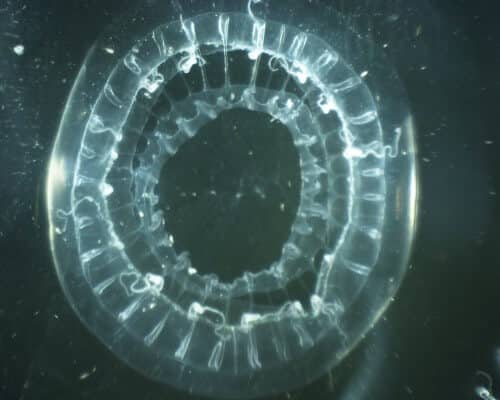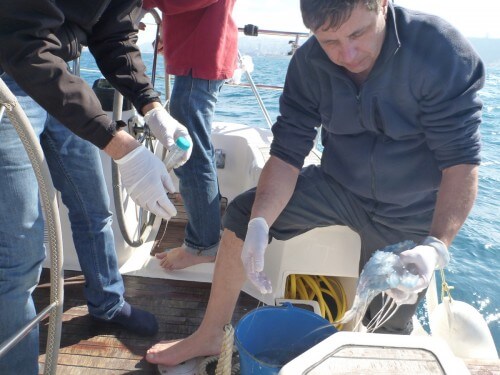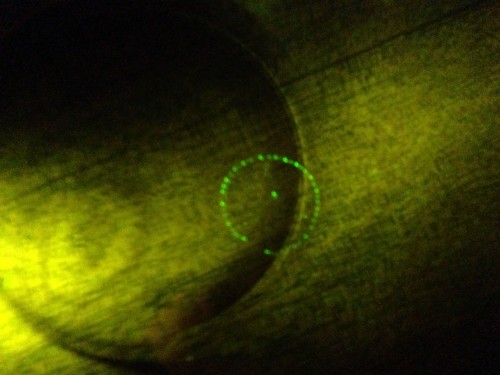A new discovery by the School of Marine Sciences at the University of Haifa - a transparent and phosphorescent jellyfish, which is common in Japan, migrated to the shores of Israel, apparently through the ballast water of merchant ships. Dr. Gur Mizrahi: "The fear is that changes in the marine environment will allow jellyfish that are dangerous to humans to migrate to this area and then the damage will be dramatic"

Meet the guest that glows in a fluorescent green color: a new jellyfish that arrived to us from Japan and was observed for the first time in the Mediterranean Sea as part of a routine survey conducted by Dr. Gur Mizrahi, a researcher at the Leon Charney School of Marine Sciences at the University of Haifa, in the laboratory of Dr. Dan Ts 'Renow: the Aequorea macrodactyla (Cnidaria Hydrozoa), which is considered widespread in the Sea of Japan. The good news: it is not dangerous to humans. The bad news: her arrival heralds that much more dangerous guests may arrive as well. "This is a particularly unique jellyfish, because it contains a phosphorescent green protein, whose presence and role are still unclear to science, despite many theories. Despite its small body - just a few centimeters - it is considered a glutton of plankton and small crustaceans, but you can remain calm - it is not dangerous to humans," said Dr. Mizrahi.
The jellyfish was observed at two sites off the coast of Israel - Haifa Bay and Beit Vinai, at a relatively shallow depth - only 10 meters. According to Dr. Mizrahi, the jellyfish knows how to utilize the water column from the shallow sea to the deep sea and has been found at significant depths up to about 1500 meters. In addition, the jellyfish's several-centimeter-long body consists of 98% water, so when it appears as individual details, it is almost impossible to distinguish it. But despite its phosphorescent color, it has a much more fascinating characteristic, "This jellyfish belongs to a class of species that are able to stay young forever. There are jellyfish in this department that are able to renew their youth, so that after they reach adulthood and produce offspring, they are able to return to an embryonic state," he explained.
The most obvious question is how the jellyfish got to the shores of Israel. One option is that the jellyfish was carried in the ballast water of merchant ships. A second possibility is that this jellyfish lived for many years in the depths of the Mediterranean Sea, but now for some reason, it has also come up to the shallower waters. After an examination called "population genetics", which uses genetic "markers" that "distill" the migration pattern and allow researchers to isolate the migrating species from local species, the most logical explanation for Dr. Mizrahi is that it is a jellyfish carried in ballast water, "beyond the results of the analysis Genetic and Morphological The fact is that no such jellyfish has been found in the vast range between Japan and Israel. In other words, the jellyfish arrived here thanks to the external intervention of humans, and not naturally," he explained.
However, whatever the reason for the appearance of the jellyfish, its survival and even its prosperity is one of the best proofs that the Mediterranean Sea is undergoing dramatic changes - potentially dangerous. "The changes often result from man's intervention in nature - overfishing can lead to the depletion of the jellyfish's natural enemies and the fact of its presence here can indicate changes on a more global level, such as the warming of the sea water. The fear is that changes in the marine environment will allow jellyfish that are dangerous to humans to migrate to this area and then the damage will be dramatic."
Dr. Mizrahi's research already shows that the presence of the jellyfish in the eastern basin of the Mediterranean can affect the environment, because it joins the local fish in competition for the same food. In this case it is plankton and small crustaceans, "but probably not in a significant way", emphasizes the researcher. The article will be published in July 2015 in the scientific newspaper NeoBiota with the collaboration of Dr. Eli Shemesh.
It should be noted that a relative of this jellyfish won three researchers, a Japanese and two Americans, the Nobel Prize in Chemistry in 2008, for their joint discovery of the luminous protein known as GFP (Green Fluorescent Protein). The protein, which emits a glowing green light under ultraviolet radiation, is widely used in research laboratories, as a tool that indicates processes occurring in living organisms, such as the development of brain cells or the spread of cancer cells, or as a measure of genetic activity. In addition, the disclosure of the way in which the protein emits light opened many doors for various researchers who, following this development, were able to mark many proteins with separate colors and thus distinguish different processes at the same time. Among the rest, the protein has been used to detect damage to nerve cells as a result of Alzheimer's disease, or to predict how insulin-producing cells are formed in the pancreas of a developing fetus.
More of the topic in Hayadan:
- Not only does vinegar not help heal jellyfish burns, it actually makes them worse
- Flight system inspired by the jellyfish
- Corals attack jellyfish



One response
It's hard with these burdens